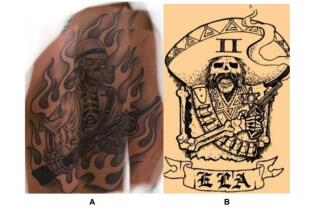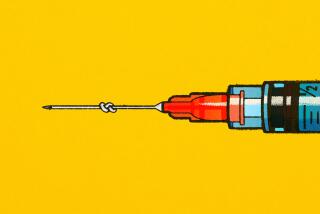Saving Your Skin
- Share via
Joanne Robbins has come a long way, from her home in Simi Valley to Irvine, to try to erase something from her past. That something is a large phoenix rising from a bed of flames tattooed on her calf. She got the tattoo seven years ago at the age of 19, during a period of “teenage angst.” Now, it no longer fits her lifestyle.
“I got over having a big giant tattoo on my leg. It’s kind of embarrassing now,” Robbins says. “People react to you differently when you have a tattoo. When you’re a teen you’re like, ‘Man, I don’t want people to judge me by looks.’ But they do.”
Robbins’ prognosis for a phoenix-free calf looks good thanks to new laser technology, which is performed at several local clinics, including the Beckman Laser Institute in Irvine and CosmetiCare in Santa Ana.
Many people, especially teens, embrace the rebellious spirits of Dennis Rodman and other celebrities who have made skin art chic. Some pledge eternal devotion to a person or group on their arm, face or neck, while a few--who are seeking to improve upon mother nature--color in their faces with permanent eyeliner, lip liner and brows.
Trendy tattooing, though, has dermatologists worried about tomorrow.
“There’s an estimated 10 million people in the U.S. who have at least one tattoo,” says Dr. Karen Benik, a Lake Forest dermatologist and assistant clinical professor at UC Irvine. “It’s not the best of trends. People do come to us two, five or 10 years later when they change their minds.
“People want to remove the past,” she says.
Time will tell whether a teen will still want that heart-and-dagger tattoo on his or her forearm at age 30, 40 or 50. Or whether a woman will one day discover that the permanent black eyeliner that gave her a Sophia Loren sophistication at 30 makes her look harsh and tired at 60.
Already some are having regrets.
Dr. Stuart Nelson, associate director of Beckman, has seen a rise in the number of patients wanting tattoos of all types removed.
“We treat anywhere from 30 to 100 [patients] a week for tattoos, and they’re increasing in frequency,” Nelson says.
Dr. Stephen Sutherland, a plastic surgeon at CosmetiCare, agrees. “The Tattoo Generation is getting older, and they’re realizing they weren’t as smart as they thought they were at 18.”
Gang-inspired tattoos are being removed more often than in the past. The Probation Community Action Assn. and the Juvenile Connection Party, both based in Orange, help a dozen or so people each week find dermatologists willing to remove the markings at little or no cost.
Tattoos are most often removed through lasers or salabrasion. Excision, in which the skin is removed, is another method of tattoo removal, but it’s painful and leaves scarring.
Lasers work on ink that’s been injected into the skin. The pure wavelength of light is absorbed by the pigment, which shatters and is absorbed by the body.
Removal usually requires a series of treatments depending on the amount and the depth of pigment injected into the skin. Treatments last about five to 15 minutes and cost $175 to $400, depending on the procedure’s length, Benik says.
“If they have a fist-sized tattoo, it can cost around $1,200,” she says.
Two to 10 treatments is the norm, and there’s no way of knowing how many treatments will be required to remove a tattoo.
*
“We never know when we start how many treatments it will take because we don’t know how deep the artist put the ink into the skin,” Nelson says.
At CosmetiCare, the sessions are separated by two months to allow the skin to recover. “A tattoo can take about year to remove,” Sutherland says.
An alternative to laser treatments is a procedure similar to dermabrasion called salabrasion, in which the top layers of the skin are virtually sanded off using a type of drill with a rotating bit. Then sodium chloride--table salt--is rubbed into the area to soak up the pigment.
Patients might find the salabrasion to be more painful but less expensive than laser treatments. A typical tattoo removal by salabrasion costs about $150 and takes about 15 minutes with the patient undergoing local anesthesia.
“It works really nicely on lighter tattoos” that are just below the surface of the skin, says Dr. Lilla Breyer, a plastic surgeon in Dana Point. “I’ve removed large eagles on men’s arms with it. But you can’t do dermabrasion around the lash lines because you could injure the eye. Those areas are extremely difficult.”
Four years ago, Selma Bicaci spent $80 for permanent eyeliner, thinking it would simplify her makeup routine. The 53-year-old Laguna Niguel resident is now undergoing a series of laser treatments by Benik to have the eyeliner removed--for about $400.
“I was so sorry I did it,” Bicaci says. “I like to go to the gym and the beach, and when I don’t have the rest of my makeup on, it looks funny. Without eye shadow, mascara and lipstick, I look horrible.”
Bicaci found herself spending more time in front of the makeup mirror because she didn’t want to be seen with just the eyeliner.
“I want to get rid of it,” she says.
Though tattoos are advertised as permanent, they change over time as the skin ages and the ink sinks deeper below the surface. Lines can shift and colors can lighten.
“The tattoos will change with you,” Benik says.
Some pigments don’t react well to the laser. Black and darker colors are usually easier to remove because the pigment in the tattoo readily absorbs the laser light, much the way black clothing will absorb infrared light from the sun. Other colors can react poorly.
Lighter pigments, especially flesh tones, are hard to remove because the light waves are not readily absorbed by the ink, Nelson says.
They can even turn a ghastly green or black--an unfortunate scenario for patients who were trying to tattoo over a scar or brown spot. The color can change because the pigment contains iron oxide, titanium or some other ingredient that reacts to the laser.
*
“Certain colors, like red around the lips, can be scary to do,” Benik says. “They can turn black or green.”
To prevent a cosmetic disaster, doctors conduct a tiny test spot of the tattoo to see how it will react to the laser. Some can’t be removed.
After seeing the unhappy consequences of tattoo procedures, Nelson would like to see the government regulate the tattoo and permanent cosmetic industry more closely.
Minors, he says, should not be able to get a tattoo without parental consent. He doesn’t expect kids to think of the long-term effects of the tattoo trend.
“They just think it’s a cool thing to do,” he says. “Hey, I was 16 once.”
for library only


